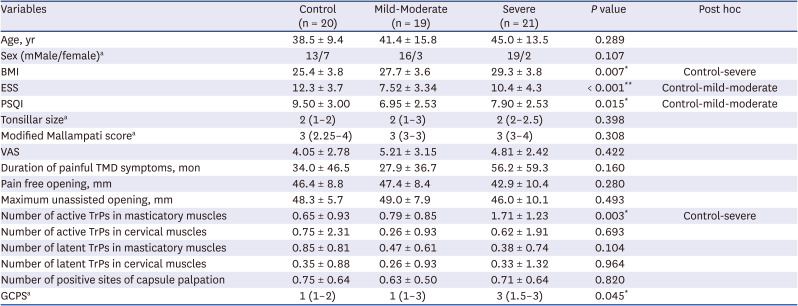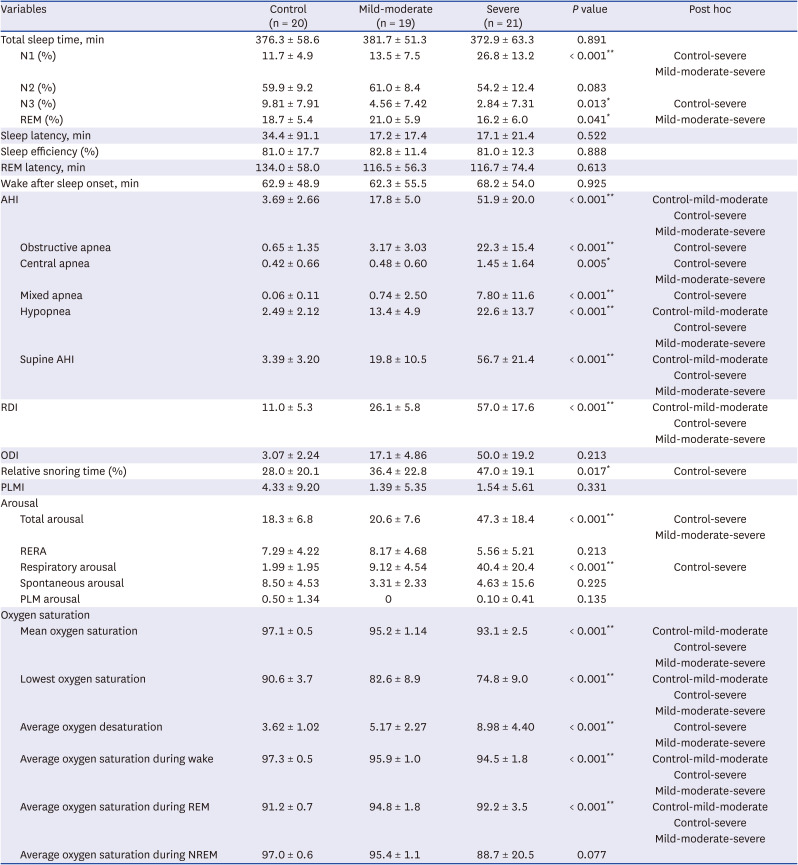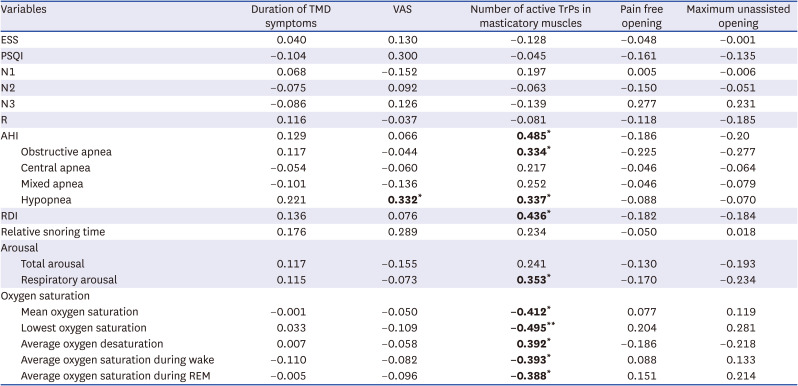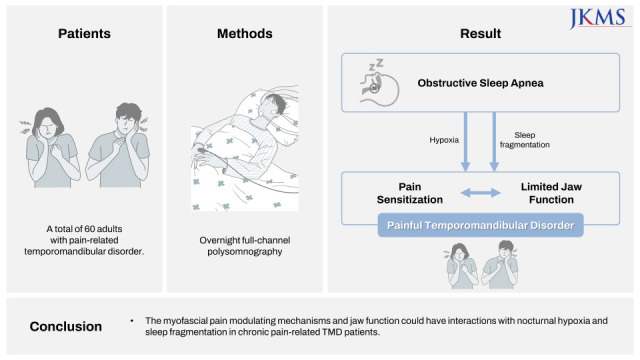1. Davies RJ, Stradling JR. The epidemiology of sleep apnoea. Thorax. 1996; 51(Suppl 2):S65–S70. PMID:
8869356.

2. Senaratna CV, Perret JL, Lodge CJ, Lowe AJ, Campbell BE, Matheson MC, et al. Prevalence of obstructive sleep apnea in the general population: a systematic review. Sleep Med Rev. 2017; 34:70–81. PMID:
27568340.

3. Yaggi HK, Strohl KP. Adult obstructive sleep apnea/hypopnea syndrome: definitions, risk factors, and pathogenesis. Clin Chest Med. 2010; 31(2):179–186. PMID:
20488280.

4. Rundo JV. Obstructive sleep apnea basics. Cleve Clin J Med. 2019; 86(9):Suppl 1. 2–9. PMID:
31509498.

5. Young T, Finn L, Peppard PE, Szklo-Coxe M, Austin D, Nieto FJ, et al. Sleep disordered breathing and mortality: eighteen-year follow-up of the Wisconsin sleep cohort. Sleep. 2008; 31(8):1071–1078. PMID:
18714778.
6. Sánchez-de-la-Torre M, Campos-Rodriguez F, Barbé F. Obstructive sleep apnoea and cardiovascular disease. Lancet Respir Med. 2013; 1(1):61–72. PMID:
24321805.

7. Kang J, Tian Z, Wei J, Mu Z, Liang J, Li M. Association between obstructive sleep apnea and Alzheimer’s disease-related blood and cerebrospinal fluid biomarkers: a meta-analysis. J Clin Neurosci. 2022; 102:87–94. PMID:
35753156.

8. Park DH, Shin CJ, Hong SC, Yu J, Ryu SH, Kim EJ, et al. Correlation between the severity of obstructive sleep apnea and heart rate variability indices. J Korean Med Sci. 2008; 23(2):226–231. PMID:
18437004.

9. Yoon IY, Jeong DU. Degree of arousal is most correlated with blood pressure reactivity during sleep in obstructive sleep apnea. J Korean Med Sci. 2001; 16(6):707–711. PMID:
11748349.

10. Alessandri-Bonetti A, Scarano E, Fiorita A, Cordaro M, Gallenzi P. Prevalence of signs and symptoms of temporo-mandibular disorder in patients with sleep apnea. Sleep Breath. 2021; 25(4):2001–2006. PMID:
33674964.

11. Dubrovsky B, Raphael KG, Lavigne GJ, Janal MN, Sirois DA, Wigren PE, et al. Polysomnographic investigation of sleep and respiratory parameters in women with temporomandibular pain disorders. J Clin Sleep Med. 2014; 10(2):195–201. PMID:
24533003.

12. Roizenblatt S, Neto NS, Tufik S. Sleep disorders and fibromyalgia. Curr Pain Headache Rep. 2011; 15(5):347–357. PMID:
21594765.

13. Lee YH, Auh QS, An JS, Kim T. Poorer sleep quality in patients with chronic temporomandibular disorders compared to healthy controls. BMC Musculoskelet Disord. 2022; 23(1):246. PMID:
35287633.

14. Aytekin E, Demir SE, Komut EA, Okur SC, Burnaz O, Caglar NS, et al. Chronic widespread musculoskeletal pain in patients with obstructive sleep apnea syndrome and the relationship between sleep disorder and pain level, quality of life, and disability. J Phys Ther Sci. 2015; 27(9):2951–2954. PMID:
26504332.

15. Nadeem R, Bawaadam H, Asif A, Waheed I, Ghadai A, Khan A, et al. Effect of musculoskeletal pain on sleep architecture in patients with obstructive sleep apnea. Sleep Breath. 2014; 18(3):571–577. PMID:
24515853.

16. Kaczmarski P, Karuga FF, Szmyd B, Sochal M, Białasiewicz P, Strzelecki D, et al. The role of inflammation, hypoxia, and opioid receptor expression in pain modulation in patients suffering from obstructive sleep apnea. Int J Mol Sci. 2022; 23(16):23.

17. Doufas AG, Tian L, Padrez KA, Suwanprathes P, Cardell JA, Maecker HT, et al. Experimental pain and opioid analgesia in volunteers at high risk for obstructive sleep apnea. PLoS One. 2013; 8(1):e54807. PMID:
23382975.

18. Smith MT, Wickwire EM, Grace EG, Edwards RR, Buenaver LF, Peterson S, et al. Sleep disorders and their association with laboratory pain sensitivity in temporomandibular joint disorder. Sleep. 2009; 32(6):779–790. PMID:
19544755.

19. Maixner W, Greenspan JD, Dubner R, Bair E, Mulkey F, Miller V, et al. Potential autonomic risk factors for chronic TMD: descriptive data and empirically identified domains from the OPPERA case-control study. J Pain. 2011; 12(11):Suppl. T75–T91. PMID:
22074754.

20. Whale K, Gooberman-Hill R. The importance of sleep for people with chronic pain: current insights and evidence. JBMR Plus. 2022; 6(7):e10658. PMID:
35866153.

21. Choy EH. The role of sleep in pain and fibromyalgia. Nat Rev Rheumatol. 2015; 11(9):513–520. PMID:
25907704.

22. American Association of Orofacial Pain. Orofacial Pain Guidelines for Assessment, Diagnosis, and Management. Chicago, IL, USA: Quintessence;2013.
23. Park JW, Chung JW. Inflammatory cytokines and sleep disturbance in patients with temporomandibular disorders. J Oral Facial Pain Headache. 2016; 30(1):27–33. PMID:
26817030.

24. Almoznino G, Benoliel R, Sharav Y, Haviv Y. Sleep disorders and chronic craniofacial pain: characteristics and management possibilities. Sleep Med Rev. 2017; 33:39–50. PMID:
27321865.

25. Samsoon GL, Young JR. Difficult tracheal intubation: a retrospective study. Anaesthesia. 1987; 42(5):487–490. PMID:
3592174.

26. Brodsky L. Modern assessment of tonsils and adenoids. Pediatr Clin North Am. 1989; 36(6):1551–1569. PMID:
2685730.

27. Sateia MJ. International classification of sleep disorders-third edition: highlights and modifications. Chest. 2014; 146(5):1387–1394. PMID:
25367475.

28. Berry RB, Budhiraja R, Gottlieb DJ, Gozal D, Iber C, Kapur VK, et al. Rules for scoring respiratory events in sleep: update of the 2007 AASM Manual for the Scoring of Sleep and Associated Events. J Clin Sleep Med. 2012; 8(5):597–619. PMID:
23066376.

29. Epstein LJ, Kristo D, Strollo PJ Jr, Friedman N, Malhotra A, Patil SP, et al. Clinical guideline for the evaluation, management and long-term care of obstructive sleep apnea in adults. J Clin Sleep Med. 2009; 5(3):263–276. PMID:
19960649.
30. Simon DG, Travell JG, Simon LS. Myofascial Pain and Dysfunction: the Trigger Point Manual. Baltimore, MD, USA: Williams & Wilkins;1999.
31. Charokopos A, Card ME, Gunderson C, Steffens C, Bastian LA. The association of obstructive sleep apnea and pain outcomes in adults: a systematic review. Pain Med. 2018; 19(Suppl 1):S69–S75. PMID:
30203008.

32. Doufas AG, Tian L, Davies MF, Warby SC. Nocturnal intermittent hypoxia is independently associated with pain in subjects suffering from sleep-disordered breathing. Anesthesiology. 2013; 119(5):1149–1162. PMID:
24025612.

33. Dreweck FD, Soares S, Duarte J, Conti PC, De Luca Canto G, Luís Porporatti A. Association between painful temporomandibular disorders and sleep quality: A systematic review. J Oral Rehabil. 2020; 47(8):1041–1051. PMID:
32395855.

34. Olmos SR. Comorbidities of chronic facial pain and obstructive sleep apnea. Curr Opin Pulm Med. 2016; 22(6):570–575. PMID:
27662470.

35. Sanders AE, Essick GK, Fillingim R, Knott C, Ohrbach R, Greenspan JD, et al. Sleep apnea symptoms and risk of temporomandibular disorder: OPPERA cohort. J Dent Res. 2013; 92(7):Suppl. 70S–77S. PMID:
23690360.
36. Yokoe T, Minoguchi K, Matsuo H, Oda N, Minoguchi H, Yoshino G, et al. Elevated levels of C-reactive protein and interleukin-6 in patients with obstructive sleep apnea syndrome are decreased by nasal continuous positive airway pressure. Circulation. 2003; 107(8):1129–1134. PMID:
12615790.

37. Fang D, Kong LY, Cai J, Li S, Liu XD, Han JS, et al. Interleukin-6-mediated functional upregulation of TRPV1 receptors in dorsal root ganglion neurons through the activation of JAK/PI3K signaling pathway: roles in the development of bone cancer pain in a rat model. Pain. 2015; 156(6):1124–1144. PMID:
25775359.

38. Kawasaki Y, Zhang L, Cheng JK, Ji RR. Cytokine mechanisms of central sensitization: distinct and overlapping role of interleukin-1beta, interleukin-6, and tumor necrosis factor-alpha in regulating synaptic and neuronal activity in the superficial spinal cord. J Neurosci. 2008; 28(20):5189–5194. PMID:
18480275.

39. Ji RR, Nackley A, Huh Y, Terrando N, Maixner W. Neuroinflammation and central sensitization in chronic and widespread pain. Anesthesiology. 2018; 129(2):343–366. PMID:
29462012.

40. de Feijter M, Katimertzoglou A, Tiemensma J, Ikram MA, Luik AI. Polysomnography-estimated sleep and the negative feedback loop of the hypothalamic-pituitary-adrenal (HPA) axis. Psychoneuroendocrinology. 2022; 141:105749. PMID:
35427952.

41. Jo KB, Lee YJ, Lee IG, Lee SC, Park JY, Ahn RS. Association of pain intensity, pain-related disability, and depression with hypothalamus-pituitary-adrenal axis function in female patients with chronic temporomandibular disorders. Psychoneuroendocrinology. 2016; 69:106–115. PMID:
27082645.









 PDF
PDF Citation
Citation Print
Print




 XML Download
XML Download